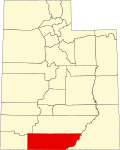2020 census
According to the 2020 United States census [15] and 2020 American Community Survey, [16] there were 7,667 people in Kane County with a population density of 1.9 people per square mile (0.7/km2). Among non-Hispanic or Latino people, the racial makeup was 6,924 (90.3%) White, 27 (0.4%) African American, 119 (1.6%) Native American, 59 (0.8%) Asian, 1 (0.0%) Pacific Islander, 18 (0.2%) from other races, and 197 (2.6%) from two or more races. 322 (4.2%) people were Hispanic or Latino.
There were 3,808 (49.67%) males and 3,859 (50.33%) females, and the population distribution by age was 1,752 (22.9%) under the age of 18, 3,950 (51.5%) from 18 to 64, and 1,965 (25.6%) who were at least 65 years old. The median age was 44.9 years.
There were 3,081 households in Kane County with an average size of 2.49 of which 1,987 (64.5%) were families and 1,094 (35.5%) were non-families. Among all families, 1,663 (54.0%) were married couples, 110 (3.6%) were male householders with no spouse, and 214 (6.9%) were female householders with no spouse. Among all non-families, 932 (30.2%) were a single person living alone and 162 (5.3%) were two or more people living together. 784 (25.4%) of all households had children under the age of 18. 2,409 (78.2%) of households were owner-occupied while 672 (21.8%) were renter-occupied.
The median income for a Kane County household was $49,486 and the median family income was $69,722, with a per-capita income of $28,142. The median income for males that were full-time employees was $41,368 and for females $34,986. 13.1% of the population and 6.0% of families were below the poverty line.
In terms of education attainment, out of the 5,600 people in Kane County 25 years or older, 480 (8.6%) had not completed high school, 1,391 (24.8%) had a high school diploma or equivalency, 2,066 (36.9%) had some college or associate degree, 1,114 (19.9%) had a bachelor's degree, and 549 (9.8%) had a graduate or professional degree.





